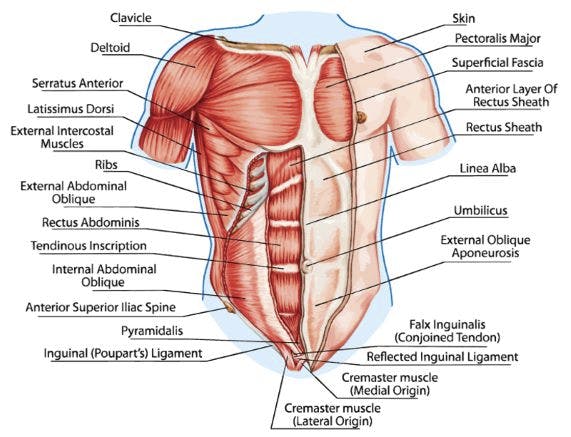Low back injuries do not always occur from one single incident or event like lifting a heavy box. Instead, most back pain occurs from small incremental stress or load applied over time. Sitting slouched for prolonged periods at a desk or repeatedly performing bending and twisting can overload structures in your back.
Muscle weakness, poor endurance, poor position awareness, and previous history of injury makes you more susceptible to low back injuries. Most of these injuries are not serious and do not require extensive testing or treatment. Most cases respond extremely well to a short course of physical therapy that includes abdominal exercises.
Abdominal Muscles and Back Pain
Your core muscles function to spare your lumbar spine from excessive load. These muscles include your abdominals, low back musculature, diaphragm, and pelvic floor. No single muscle is more important than the others. Human movement and low back pain are more complex than one muscle or structure. Instead, all your muscles should function together in coordination. Pain interferes with coordination and control.

The specific task being performed determines the magnitude and timing of your core muscle activation. Some tasks require a very low load and level of muscle activity such as bending to tie your shoes. Other tasks require greater muscle activation patterns at high speeds such as swinging a baseball bat.
Abdominal Exercises and Back Pain
Exercises to train your core muscles begins with low loads focusing on your control and endurance. Exercises performed lying on your back targeting your abdominal muscles are a great place to start.
The following exercises can be performed even if you have low back pain. They are also beneficial if you have a history of back pain and are looking to prevent recurrences. Once these exercises are no longer challenging, progression is needed. To see a few exercise progressions go here.
Abdominal Bracing
Begin lying on your back with your hips and knees bent. Find a neutral spine position by gently rocking your pelvis back and forth. Your neutral position is somewhere between a fully arched and fully flattened position. In your neutral position, you should be able to hold a small grape under your low back without crushing it.
Maintain a neutral spine and gently contract your abdominal muscles in the front and sides continuing 360 degrees around the low back. This muscle contraction should be gentle and without movement.
Once a neutral spine is maintained with gentle bracing, breathing is added. Diaphragmatic breathing is performed while maintaining a neutral spine and gentle bracing. This involves expanding through your belly and rib cage in a 360-degree fashion. Minimal or no movement occurs in your upper chest and shoulders. Five deep slow breaths are performed while maintaining a neutral spine and bracing. No breath-holding or movement of the spine should occur. It is helpful to place one hand on the abdomen and the other hand on the chest to ensure a proper breathing pattern is maintained. This exercise forms the foundation for all subsequent abdominal exercise progression to follow.
Bent Knee Fall Out
The bent knee fall out is performed after abdominal bracing and diaphragmatic breathing are mastered. Begin with a neutral spine, bracing, and diaphragmatic breathing. Lower one knee to the side towards the floor in a slow and controlled fashion. No movement in the spine or hips occurs. It is helpful to place your hands on your hip bones to ensure no movement is taking place. With each repetition alternate sides. To increase the challenges add a resistance band around your thighs. Perform 10 slow repetitions on each side.
90/90 March
This exercise begins with a neutral spine, bracing, and diaphragmatic breathing. Elevate your legs so your hips and knees are at right angles. Maintain a neutral spine, bracing, and proper breathing as you slowly alternate lowering the heels to the floor. Gently touch your heel to the floor without relaxing. Perform 10 slow repetitions on each side.
Heel Hover
Begin with a neutral spine, bracing, and diaphragmatic breathing. Elevate your legs so your hips and knees are at right angles. Maintain a neutral spine, bracing, and proper breathing as you slowly alternate extending the knee so one leg straightens without touching down. As you lower the legs, it is important that the low back does not arch away from the floor. Perform 10 slow repetitions on each side.
Double Leg Lift
Begin with a neutral spine, bracing, and diaphragmatic breathing. Elevate both of your feet so your hips and knees are at right angles. Maintain a neutral spine, bracing, and proper breathing as you slowly lower the legs together. Do not touch down or relax the feet to the floor. Your low back mustn’t arch away from the floor. Perform 10 to 20 slow repetitions on each side. To increase the challenges add a small ball to squeeze between the thighs.
Begin Abdominal Exercises for Your Back Pain
Pain interferes with how your brain transmits signals to your muscles. This is especially important when your back pain has persisted for more than several weeks. These 5 abdominal exercises re-program the lost connections between your brain and core muscles. Slow coordinated and controlled movements are crucial for success.
Absolutely no holding of your breath should occur. Breath-holding increases the tension throughout your body. This interferes with the retraining of your muscles and nervous system.
Practice these exercises, master them, and improve your endurance by increasing repetitions. Once these goals are achieved, you are ready to build strength and resilience with more challenging exercises. Call your physical therapist if you need more help finding the right exercises for your goals.


